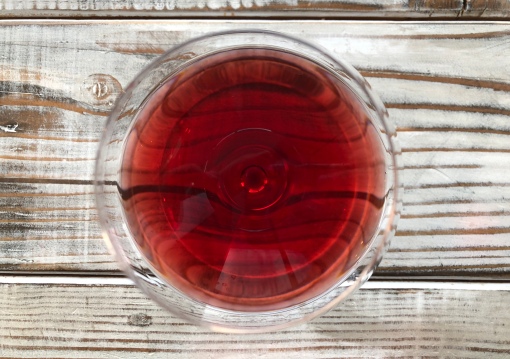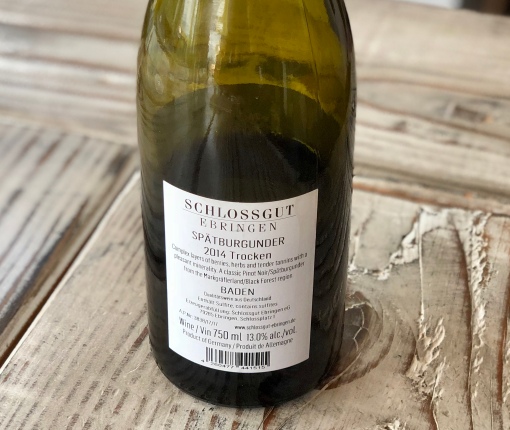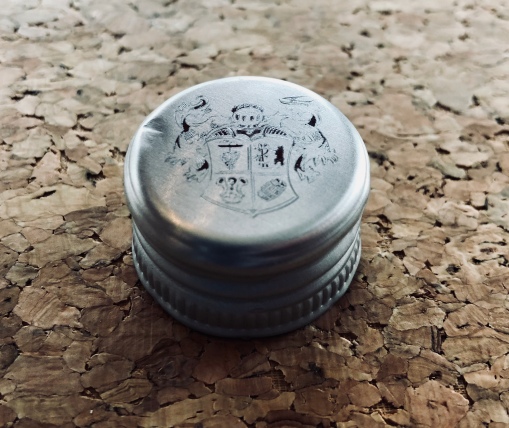By Peter Vetsch
[This bottle was provided as a sample for review purposes.]
Ever since I first got into wine about a decade ago, I have come across the eternal, nigh-unsolvable question many times: where can you look for consistent, top-quality, good-value Burgundy? Well, I have finally solved the riddle — turns out it’s been in Germany all along.

Mesmerizing. Germany, wow.
It might not be in France, and it might have just broken my heart in the World Cup, but Germany has been quietly elevating its Pinot Noir bona fides. This fickle and finicky red grape is known here as Spätburgunder (literally, “late Pinot”, or “late Burgundy”, due to its relatively late-ripening tendencies) and is in the process of taking the next step in Germany’s warmer climes, aided imperceptibly by climate change and to a larger degree by greater clonal awareness and vineyard attention. But it is not every country that can suddenly become a Pinot success story; Germany’s natural advantages (including patches of Burgundian-style limestone soil) are finally being properly cultivated, and almost as importantly, shared with the world.

I don’t think I had ever seen a wine from Germany’s Baden region on an Alberta retail shelf until 2018, and after a taste of what Schlossgut Ebringen can do with possibly the hardest grape of all to do well (and don’t even get me started on their utterly mind-bending Chasselas “S”, which belongs in another dimension), it makes me wonder what has taken us so long to get on board. A quick primer for the uninitiated: Baden is in the extreme southwest corner of Germany, just a stone’s throw and a border crossing away from Alsace, due west from Munich until you almost hit France. It is closer to Zurich, Switzerland than any major German city. Baden is built like Chile, in a long narrow north-south stripe, within which lies 9 surprisingly different subregions. Pinot Noir/Spätburgunder is the most commonly planted grape (at around 35% of all plantings), though on the whole white grapes outnumber reds 60/40. In the south of Baden, just south of the famous Baden-Baden spas, lies the top subregion of Markgräflerland, known largely for Chasselas (locally known as “Gutadel” just to add more proper nouns to your life) but also a burgeoning Pinot power. Baden’s other top attraction, the Black Forest (Schwarzwald), lies to the east, and in its foothills lies the village of Ebringen and the hero of tonight’s story.

Yes, I had to study for this. One of my first Baden wines!
Andreas Engelmann is the estate manager and winemaker who has elevated Schlossgut Ebringen from a relative unknown to a leading light in Baden in just over a decade. Under his guidance, top vineyards that had previously contributed grapes to a larger cooperative were separately leased and isolated to showcase their true potential, including those on Ebringen Sommerberg (“Summer Mountain”), a large multi-hectare south-by-southwest-facing hillside on the outskirts of the village and close to the Rhine, from which tonight’s bottle hails. This part of Markgräflerland is one of the warmest viticultural areas in Germany, yet still only has an average annual temperature of 9.7C, making it an ideal cool-climate host for a grape like Pinot that shines best in those temperate conditions. Despite being an introductory-level offering (at a shade under $30 retail), this single-site bottling is the beneficiary of all of Englemann’s exhaustive vineyard practices, from extensive pruning and yield reduction to cover crops and organic fertilization. Native yeast fermentation and careful oak maturation yield a Pinot Noir that punches above its category (it is technically somehow a Gutswein, or regional wine, the lowest on the formal quality pyramid) in every conceivable way.

This Spätburgunder immediately catches the eye thanks to its shimmering, openly transparent ruby colour, then holds the attention with spicy, savoury aromas of cinnamon sticks and Herbes de Provence overtop of mincemeat, new pennies, fresh raspberry and cranberry, as well as hints of something darker and more confectionary, baker’s chocolate and grape Fruit Roll-Up. Despite this playful indulgence around the edges, it remains continually poised, restrained and classically styled…until the second it hits the tongue, that is, when it absolutely explodes with energy. The Pinot vibrates and pulsates like it can’t sit still and shimmies and shifts like it’s failing a polygraph. There is none of that hollow thinness in the midpalate that can assail sub-stratospheric Old World Pinot Noir, no gaps or instances of fading flavour, yet the wine somehow retains its delicacy without ever losing its substance.

Stelvin Rating: 8.5/10 (Definitely in favour of the coat-of-arms screwcap look, and the silver.)
Lavender, crushed rocks (yes, there is some limestone laced around Ebringen Sommerberg), incense, violets and celery flitter around a darker fruit profile and a pulsing heart of lean acidity, the engine that makes this welterweight demon go. This is very German in a way, classic and precise and delineated, but it’s also open and approachable, and in a beautiful place right now, singing in harmony and ready to enjoy on any manner of occasion, whether it’s getting the kids to bed on a Wednesday night (still a work in progress on this end) or blissfully pondering the wonders of the universe. It’s been a while since I really paid attention to a wine, since I pulled my bleary eyes into focus and stopped the hundred other things I was doing to listen to what somebody else’s creation was truly saying, and the process of unwinding this bottle and igniting that connection made me realize why it’s always worth the effort with the good ones.
91 points
$25 to $30 CDN



Hello 🙂 Any pairing suggestions as I am looking at including this wine in an October wine pairing event I am hosting…
LikeLike
Hi Dawn! I wouldn’t weigh this down with anything too rich or heavy, but I also wouldn’t err too far on the delicate side either, as there’s enough oomph in the wine to stand up to some flavour. My initial thought is that something involving duck breast or quail, or salmon or arctic char, would be in the right ballpark. Hope that helps!
LikeLike